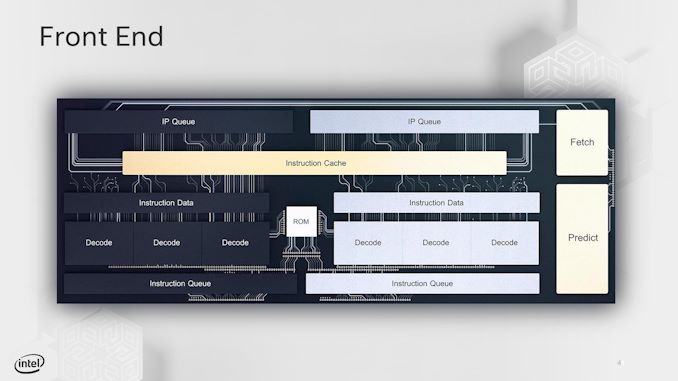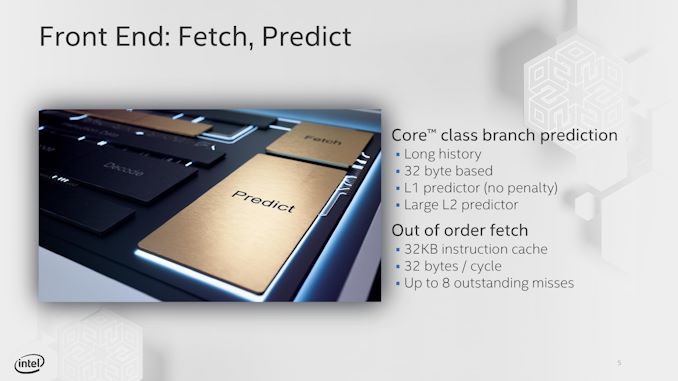Intel's new Atom Microarchitecture: The Tremont Core in Lakefield
by Dr. Ian Cutress on October 24, 2019 1:30 PM ESTTremont: A Wider Front End and Caches
For users that have been following our analysis of the Core microarchitecture, it has been hard not to notice that Intel’s design for that family has been, among other things, to continually go wider and wider. This means more instructions in flight, larger caches, bigger buffers, bigger TLBs, more execution ports, and support for more instructions. Going wider isn’t the only thing: the microarchitecture also has to be clever, trying to maximise utilisation, as going wider does nothing for a simple stream of commands.
With Atom, going wider is a key part of the design for Tremont, but Intel has taken a couple of fundamentally different steps to manage exactly what is going on.
A Key Uplift: Fetch and Predict
Another major jump for the Atom microarchitecture are the prefetchers and branch predictors. Intel states that rather than iterate the design from Goldmont Plus, they have transplanted a large part of the prefetchers and branch predictors from the Core design on Sunny Cove. The design isn’t identical according to Intel, due to die area and power concerns, but Intel states that the principles are similar and elements like branch prediction history tables are ‘of the same order’ as the Core design.
Intel states that there is no penalty for an L1 prediction, and that the L2 prediction penalty is smaller than previous generations.
A Key Differentiator: Decode Engines
On the face of it, we have a 6-wide decode engine pared with a 4-wide allocation/dispatch engine. This is, on paper, very odd: normally we would expect the decode and dispatch to be equal in width, or at least be able to dispatch more than can be decoded in order to ensure that the re-order buffer doesn’t overflow. With the latest Core microarchitecture, called Sunny Cove, we have a 4-to-6 wide decode that also supports a micro-op cache, which all leads into a large reorder buffer and a 10-wide dispatch to the back-end. Tremont is, by contrast, has the opposite ratio.
Saying that this is a 6-wide decode engine is actually slightly incorrect. What Intel has done here is split the decode into dual 3-wide engines instead.
Each decode engine, when dealing with different branch predictions, can take a separate instruction stream. This allows for a higher average utilization across both of the 3-wide decode engines compared to a single 6-wide engine, but when a branch isn’t present it means that one of the decode engines can be clock gated to save power. For a single instruction stream, the Tremont design is actually only 3-wide decode, with a 4-wide dispatch.
(Technically Intel states that, through microcode, they can change the decode engines to act as a single 6-wide implementation rather than dual 3-wide engines. This won’t be configurable to the OEM, but based on demand Intel may make specific products for customers that request it.)
So just to clarify, Tremont does not have a micro-op cache. When discussing with Intel about the benefits of this dual decode engine design compared to having a micro-op cache, Intel stated that a micro-op cache can help utilize a wide-decode design better, but with a smaller per-engine decode size, they were able to see a performance uplift as well as save die area by using this dual-engine design. Intel declined to comment which one was better, but we were told that given the die size, power envelope of Atom, and the typical instruction flow of an Atom core, this design yielded the better combination of performance, power, and area.
Another improvement for Intel after the decode engines is the re-order buffer. Intel states that it can support 208 instructions, compared to 78 in Goldmont and 95 in Goldmont Plus, which is a sizeable uplift. Intel did not specify if Tremont has the ability to fuse instructions into micro-ops for the ROB (Goldmont did not), however there is a near 1:1 parity of instructions to micro-ops we were told.
Caches
Intel has also increased the size of its L1 data cache. The L1 instruction cache says at 32 KiB/core with 8-way associativity, but ever since the 22nm era, Intel has kept a 24 KiB/core L1 data cache on its Atom design. With Tremont, both the L1-I and L1-D are now a 32 KiB/core design with 8-way associativity. Intel states that its L1 data cache here has a 3-cycle latency, compared to Skylake which has a 32 KiB L1D at a 4-cycle latency, or Sunny Cove which has a 48 KiB L1D at a 5-cycle latency.
| Intel Caches | ||||||
| AnandTech | Tremont | Goldmont+ | Goldmont | Sunny Cove | Skylake | |
| Process | 10+ | 14 | 14 | 10+ | 14++ | |
| Decode | 2x3-wide | 3-wide | 3-wide | 4-6 wide | 4-5 wide | |
| Allocate | 4-wide | 4-wide | 3-wide | 10-wide | 8-wide | |
| L1 Instruction | 32 KiB/Core 8-way |
32 KiB/Core 8-way |
32 KiB/Core 8-way |
32 KiB/Core 8-way |
32 KiB/Core 8-way |
|
| L1 Data | 32 KiB/Core 8-way |
24 KiB/Core 6-way |
24 KiB/Core 6-way |
48 KiB/Core 12-way |
32 KiB/Core 8-way |
|
| L1 Latency | 3-cycle | 3-cycle | 3-cycle | 5-cycle | 4-cycle | |
| L2 Cache | 1.5-4.5 MiB Per Module 12-18 way |
1.0 MiB Per Core 16-way |
0.5-1.0 MiB Per Core 16-way |
512 KiB Per Core 8-way |
256 KiB Per Core 4-way |
|
| L2 Latency | 17-cycle | 19-cycle | 17-cycle | 13-cycle | 12 cycle | |
For the L2 cache, for most Atom cores in the past, this has essentially been a last-level cache split across all cores in a ‘module’. Depending on the generation will depend on the size of the module: for 22nm Silvermont, we saw an L2 cache of 512 KiB/core, which was increased with Goldmont up to 1.0 MB/core. With Tremont, Intel has specified that L2 will vary depending on the product, from 1.5 MiB to 4.5 MiB per module. A module for Tremont will be anything up to four cores, so we could see designs with a single core featuring 4.5 MiB of L2 cache, or a quad-core design with 1.5 MiB of L2. Within a module, all cores have access to the cache, however a core will not have access to the L2 in a different module. The L2 can be set through microcode as an inclusive or a non-inclusive cache.
Intel states that the L2 cache has an average 17-cycle latency, and the associativity will be a function of the size: 1.5 MB will be a 12-way design, while 4.5 MB will be an 18-way design. (We therefore assume that a 3.0 MB L2 will be 15-way.)
Tremont also adds support for a global L3 cache across modules. Both the L2 and L3 cache support QoS arrangements, allowing for data prioritization and memory bandwidth enforcement for specific threads or virtual machines. This is a technology that Intel introduced with Broadwell Xeons to help avoid ‘noisy neighbor’ environments in data centers.













101 Comments
View All Comments
vladx - Friday, October 25, 2019 - link
Obviously Intel waited until it was left with no choice.Ratman6161 - Friday, October 25, 2019 - link
"Did Atom processors ever stop sucking?"Actually I don't believe they ever started sucking. As with many things, once OEM's decided they were for cheap systems, they built systems where everything else was cheap too. Atom was never designed for high performance and when you combined it in a laptop where everything in it was the cheapest the manufacturer could get...you got crap. I think within its niche it wasn't really half bad.
I've Got an Asus Zenbook S8 with an Atom Z3580 running Android 6 and it was actually pretty fast for an Android tablet of its day. It competed well with Samsung's tablets at that time and was a fraction of the cost ($249 on Amazon back then). I still use it and its still more than adequate for web surfing, email, Netflix, Amazon Prime video etc. Keep Atom where it belongs and don't set unreasonably high expectations for it and it doesn't suck.
mode_13h - Saturday, October 26, 2019 - link
I dunno... did x86 processors ever stop sucking?They do deliver good perf/W - better than Intel's big cores, but still not as good as ARM.
Korguz - Sunday, October 27, 2019 - link
" if they are not as good as arm " how so ??Namisecond - Friday, November 1, 2019 - link
Not as good perf/W but we are comparing ARM to x86 here.olde94 - Saturday, October 26, 2019 - link
that widely depends on your application. as far as i understand atoms are widely used in servers due to their power consumption, low heat output and focus on CPU performance compared to other mainstream cpu's. so yeah for some applications atoms are quite ok.olde94 - Saturday, October 26, 2019 - link
a system like this https://www.supermicro.com/products/system/3U/5039... is a single server rack with a total of 192 cores at less than 400W. and while it's atom cores i would like to have you realize that they run at 2.1ghz, wheres a system like a Gold CPU 6148 x2 is a 40 core @2.4ghz at above 300w. so while the xeon has better IPC we are talking about a 40c vs 192c system at a comparable power budget runing a frequency that is similar. so the xean need more then 4x better IPC to win here. once again there are a lot of features the atom does not support and the IPC surely is different, but atom is not "just" badCalista - Sunday, October 27, 2019 - link
Atom have come a really long way from its earliest versions. Try using something like a N270 and compare it to an X5-E8000. The former will be completely unusable, the later not really zippy but more than fast enough for most common workloads except gaming.yeeeeman - Sunday, March 15, 2020 - link
Silvermont based tablets that sold at 100 bucks were amazing value for money.You should stop sucking whatever you are sucking, because atom was quite good after silvermont launched.
ternnence - Thursday, October 24, 2019 - link
The two ALUs have one focused on fused additions (FADD), while the other focuses on fused multiplication and division (FMUL).fadd != fused add, fadd = float point add